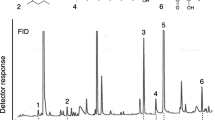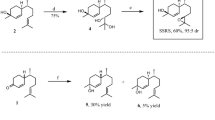Abstract
Invasion by the Argentine ant Linepithema humile (Mayr) (Hymenoptera: Formicidae) causes the collapse of global ecosystems. Attempts to exterminate this invasive ant have mostly been unsuccessful after colonization. However, some attempts are successful when they are applied in the initial stage of invasion, or the invaded area is limited. This indicates that early identification of invasion is crucial for successful extermination. The current methods of identification require special training and skills, suggesting that a new easy and fast method of identification is urgently required. Here, we report a method of identification using a species-specific trail pheromone. The Argentine ant uses (Z)-9-hexadecenal as a trail pheromone. (Z)-9-Hexadecenal is commercially available, because it is used to control the reproduction of a moth (Chilo suppressalis). We applied (Z)-9-hexadecenal 10 cm away from the trails of Argentine ants and 12 native Japanese ant species. The Argentine ant trails were largely disturbed, while the effect on the native Japanese ants was almost undetectable. These results suggest that this “trail disruption identification method” is an easy and fast method of identifying Argentine ants in Japan and that the effects of this method on native Japanese ants, if any exist, are small.



Similar content being viewed by others
References
Choe DH, Villafuerte DB, Tsutsui ND (2012) Trail pheromone of the Argentine ant, Linepithema humile (Mayr) (Hymenoptera: Formicidae). PLoS One. https://doi.org/10.1371/journal.pone.0045016
Gómez C, Pons P, Bas JM (2003) Effects of the Argentine ant Linepithema humile on seed dispersal and seedling emergence of Rhamnus alaternus. Ecography 26:532–538. https://doi.org/10.1034/j.1600-0587.2003.03484.x
Holway DA (1999) Competitive mechanisms underlying the displacement of native ants by the invasive argentine ant. Ecology 80:238–251. https://doi.org/10.1890/0012-9658(1999)080%5b0238:CMUTDO%5d2.0.CO;2
Holway DA, Suarez AV, Case TJ (1998) Loss of intraspecific aggression in the success of a widespread invasive social insect. Science 282:949–952. https://doi.org/10.1126/science.282.5390.949
Holway DA, Lach L, Suarez AV, Tsutsui ND, Case TJ (2002) The causes and consequences of ant invasions. Annu Rev Ecol Syst 33:181–233
Human KG, Gordon DM (1997) Effects of Argentine ants on invertebrate biodiversity in northern California. Conserv Biol 11:1242–1248. https://doi.org/10.1046/j.1523-1739.1997.96264.x
Inoue MN, Sunamura E, Suhr EL, Ito F, Tatsuki S, Goka K (2013) Recent range expansion of the Argentine ant in Japan. Divers Distrib 19:29–37. https://doi.org/10.1111/j.1472-4642.2012.00934.x
Keller L, Passera L, Suzzoni J-P (1989) Queen execution in the Argentine ant, Iridomyrmex humilis. Physiol Entomol 14:157–163. https://doi.org/10.1111/j.1365-3032.1989.tb00947.x
Nishisue K, Sunamura E, Tanaka Y, Sakamoto H, Suzuki S, Fukumoto T, Terayama M, Tatsuki S (2010) Long-term field trial to control the invasive Argentine ant (Hymenoptera: Formicidae) with synthetic trail pheromone. J Econ Entomol 103:1784–1789. https://doi.org/10.1603/ec10008
Plentovich S, Swenson C, Reimer N, Richardson M, Garon N (2010) The effects of hydramethylnon on the tropical fire ant, Solenopsis geminata (Hymenoptera: Formicidae), and non-target arthropods on Spit Island, Midway Atoll, Hawaii. J Insect Conserv 14:459–465. https://doi.org/10.1007/s10841-010-9274-6
R Development Core Team (2019) The R: project for statistical computing. https://www.r-project.org/
Silverman J, Brightwell RJ (2008) The Argentine ant: challenges in managing an invasive unicolonial pest. Annu Rev Entomol 53:231–252. https://doi.org/10.1146/annurev.ento.53.103106.093450
Suarez AV, Richmond JQ, Case TJ (2000) Prey selection in horned lizards following the invasion of Argentine ants in southern California. Ecol Appl 10:711–725. https://doi.org/10.1890/1051-0761(2000)010%5b0711:PSIHLF%5d2.0.CO;2
Sunamura E, Espadaler X, Sakamoto H, Suzuki S, Terayama M, Tatsuki S (2009a) Intercontinental union of Argentine ants: Behavioral relationships among introduced populations in Europe, North America, and Asia. Insectes Soc 56:143–147. https://doi.org/10.1007/s00040-009-0001-9
Sunamura E, Hatsumi S, Karino S, Nishisue K, Terayama M, Kitade O, Tatsuki S (2009b) Four mutually incompatible Argentine ant supercolonies in Japan: inferring invasion history of introduced Argentine ants from their social structure. Biol Invasions 11:2329–2339. https://doi.org/10.1007/s10530-008-9419-7
Sunamura E, Suzuki S, Nishisue K, Sakamoto H, Otsuka M, Utsumi Y, Mochizuki F, Fukumoto T, Ishikawa Y, Terayama M, Tatsuki S (2011) Combined use of a synthetic trail pheromone and insecticidal bait provides effective control of an invasive ant. Pest Manag Sci 67:1230–1236. https://doi.org/10.1002/ps.2172
Tanaka Y, Nishisue K, Sunamura E, Suzuki S, Sakamoto H, Fukumoto T, Terayama M, Tatsuki S (2009) Trail-following disruption in the invasive Argentine ant with a synthetic trail pheromone component (Z)-9-hexadecenal. Sociobiology 54:139–152
Tatsuki S (1990) Status of application of sex pheromone of rice stem borer moth, Chilo suppressalis in Japan. Int J Trop Insect Sci 11:807–812. https://doi.org/10.1017/s1742758400021378
Tatsuki S (2009) The use of synthetic sex pheromone. In: Kiritani K, Tatsuki S (eds) The rice stem borer, Chilo suppressalis. A history of applied entomology in Japan. University of Tokyo Press, Tokyo, pp 135–148
Tingle CCD, Rother JA, Dewhurst CF, Lauer S, King WJ (2003) Fipronil: environmental fate, ecotoxicology, and human health concerns. Rev Environ Contam Toxicol 176:1–66
Acknowledgements
We thank two anonymous referees for thoughtful comments on the manuscript. We grateful thank all the members of the laboratory of ethology, Tokyo University of Agriculture and Technology, for support and helpful discussions, Takehiko Fukumoto, Shin-Etsu Chemical Co., for providing the pheromone dispensers, the people of Kuroiso, Iwakuni City for providing experimental fields and hospitality, and Dr. Yuya Fukano and Dr. Shinya Hayashi for analytical advice. We are grateful to Dr. Eiriki Sunamura for important advices and supports. We would like to thank Editage (http://www.editage.com) for English language editing.
Author information
Authors and Affiliations
Corresponding author
Additional information
Publisher's Note
Springer Nature remains neutral with regard to jurisdictional claims in published maps and institutional affiliations.
Electronic supplementary material
Below is the link to the electronic supplementary material.
Rights and permissions
About this article
Cite this article
Nishisue, K., Koyama, S. & Satoh, T. Identification of the Argentine ant Linepithema humile (Hymenoptera: Formicidae) using an artificially synthesized trail pheromone and its effects on native Japanese ants. Appl Entomol Zool 55, 141–147 (2020). https://doi.org/10.1007/s13355-019-00663-9
Received:
Accepted:
Published:
Issue Date:
DOI: https://doi.org/10.1007/s13355-019-00663-9




